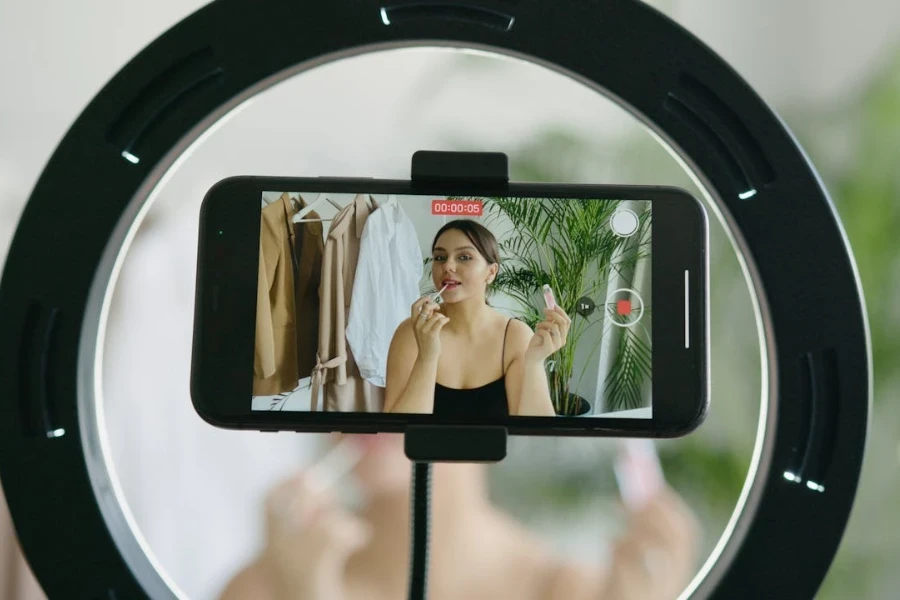Brands already know influencer marketing is the future of marketing because it’s clearly effective. But why does it work? Let’s talk about how partnering with beauty influencers can boost sales for your beauty brand.
Table of Contents
Understanding influencer marketing
Impact of influencers on purchasing decisions
Other ways partnering with influencers boosts sales
How long-term influencer partnerships boost sales
Final thoughts
Understanding influencer marketing
Influencer marketing involves collaborating with individuals who have an engaged following on social media platforms to promote products or services. These influencers, ranging from micro-influencers with niche audiences to macro-influencers with massive reach, can sway their followers’ purchasing decisions through authentic recommendations and engaging content.
According to PR Newswire, the global influencer marketing industry was valued at US $10.6 billion in 2023 and is projected to reach US $50.3 billion by 2028.
Impact of influencers on purchasing decisions
One of the primary reasons brands partner with influencers is their ability to influence purchase decisions. A survey conducted by Twitter and Annalect revealed that 49% of consumers rely on influencer recommendations for their purchase decisions. Moreover, 40% of respondents reported purchasing after seeing an influencer use the product or service on social media.
A prime example of a brand that leveraged influencer marketing to achieve remarkable success is Daniel Wellington, a Swedish watch company. By collaborating with fashion influencers on Instagram, Daniel Wellington amassed a massive following and achieved explosive sales growth. Within a few years, the company’s revenue soared to over US $200 million annually, attributing much of its success to influencer partnerships.
Other ways partnering with influencers boosts sales

Enhanced brand awareness
In addition to driving sales, influencer marketing helps enhance brand awareness and visibility. By partnering with influencers who align with your target audience, brands can amplify their reach and tap into new markets.
Research by Mediakix found that 89% of marketers believe influencer marketing ROI is comparable to or better than other marketing channels, with increased brand awareness cited as one of the primary benefits. Another study by Linqia found that despite the pandemic, 39% of marketers increased their influencer marketing budgets in 2020.
Gymshark, a fitness apparel brand, effectively utilized influencer marketing to build a cult-like following among fitness enthusiasts worldwide. By collaborating with fitness influencers and athletes, Gymshark expanded its reach beyond traditional marketing channels and established itself as a dominant player in the activewear industry. The brand’s strategic partnerships with influencers contributed to its rapid growth and global recognition.
Build authenticity and trust
One of the key drivers of influencer marketing’s effectiveness is the authenticity and trust associated with influencer endorsements. Unlike traditional advertising, which can be perceived as intrusive or insincere, influencer recommendations feel genuine and relatable to their followers.
According to MuseFind, 92% of consumers trust an influencer more than a celebrity endorsement or traditional advertising. Additionally, a study by gen.video found that 33% of people said influencers are trusted sources when making shopping decisions. In comparison, only 17% trusted friends and family for shopping recommendations.
Micro-influencers and niche markets
While macro-influencers with millions of followers command attention, micro-influencers with smaller, more engaged audiences can be equally impactful, especially when targeting niche markets.
Research by Markerly found that engagement rates tend to decrease as the number of followers increases. Therefore, partnering with micro-influencers with a loyal following within a specific niche can yield higher brand engagement and conversion rates.
Glossier, a beauty brand known for its following and minimalist aesthetic, leveraged the power of micro-influencers to build brand loyalty and drive sales. By collaborating with beauty enthusiasts and bloggers with smaller but highly engaged followings, Glossier created authentic content that resonated with its target audience. This grassroots approach contributed to Glossier’s rapid growth and success in the competitive beauty industry.
How long-term influencer partnerships boost sales
Long-term brand partnerships involve establishing ongoing relationships between beauty brands and select influencers over an extended period of time. These collaborations prioritize consistency, authenticity, and mutual trust, with influencers serving as brand ambassadors or advocates rather than just promotional partners. Long-term partnerships focus on building meaningful connections with influencers and their audiences, fostering brand loyalty and affinity over time.
Benefits of long-term brand partnerships
- Authenticity and trust: Long-term collaborations enable brands to cultivate authentic relationships with influencers, fostering trust and credibility among their audiences. Consistent endorsements from trusted influencers can strengthen brand perception and loyalty.
- Sustained engagement and impact: By nurturing long-term partnerships, beauty brands can maintain engagement with influencers’ audiences over time, maximizing the impact of campaigns and driving lasting brand awareness and affinity.
- Strategic alignment and integration: Long-term collaborations allow for deeper integration of influencers into brand marketing strategies, aligning content creation with broader brand objectives and messaging. This strategic alignment enhances campaign effectiveness and coherence.
Of course, there are also a few possible downsides to longer-term partnerships, for example:
- Resource-intensive: Establishing and maintaining long-term partnerships requires significant time, resources, and effort from brands and influencers. This ongoing commitment may be challenging for businesses with limited resources or bandwidth.
- Risk of overexposure: Long-term partnerships risk overexposure or audience fatigue if not managed carefully. Brands must balance consistency with variety in content and messaging to keep audiences engaged and avoid monotony.
- Dependency on influencers: Relying heavily on long-term partnerships with a few influencers can pose risks in the event of changes in influencers’ popularity, behavior, or market relevance. Brands should diversify their influencer portfolio to mitigate dependency risks.
Both influencer partnerships and long-term brand collaborations offer unique advantages and considerations for beauty businesses seeking to boost sales and enhance brand visibility. Influencer partnerships provide flexibility and agility, while long-term collaborations prioritize authenticity and sustained engagement.
To make informed decisions, beauty brands must carefully evaluate their marketing objectives, budgetary constraints, and brand-building priorities, selecting the approach that best aligns with their goals and resources.
Whether opting for short-term partnerships or investing in long-term relationships, beauty businesses can leverage the power of influencers to drive sales, foster brand loyalty, and achieve sustained growth in the competitive beauty industry.
Final thoughts
Partnering with influencers can be a game-changer for brands looking to boost sales, enhance brand awareness, and connect with their target audience on a deeper level. By harnessing the power of influencer marketing and leveraging influencers’ authenticity, trust, and reach, brands can create meaningful connections with consumers and drive tangible business results.
As the influencer marketing landscape continues to evolve, brands that embrace this strategy and adapt to changing consumer preferences will undoubtedly reap the rewards of increased sales and sustained growth.




